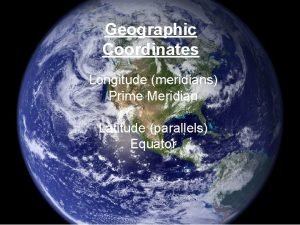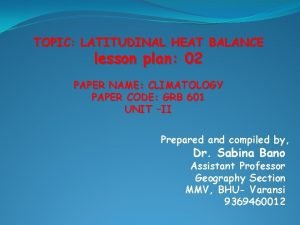Ecosystem Properties along a Latitudinal Gradient of the

- Slides: 1

Ecosystem Properties along a Latitudinal Gradient of the Yamal Region, Russia Howard E. Epstein 1, Donald A. Walker, Patrick Kuss, Elina Kaarlejävi, George Matyshak 1 Department of Environmental Sciences, University of Virginia, Charlottesville, VA 22904 -4123 INTRODUCTION An understanding of land-atmosphere and biogeochemical cycling in any system is predicated by knowledge of the spatial distribution of vegetation and soil properties, and the capacity for elements to move among the various system components, including plants, soils, and atmosphere. In many regions of the Siberian arctic tundra, this baseline information on vegetation and soils in a spatial context does not exist in any systematic fashion. As part of a U. S. NASA/NEESPI Land Cover Land Use Change project, we analyzed in detail the vegetation and soil properties of three tundra locations along a latitudinal gradient in forest-tundra and arctic tundra in the Yamal Region of Siberia east of the Ural Mountains. RESULTS – Vegetation Indices METHODS Our locations were situated near Nadym (65° 18’ N), Laborovaya (67° 41’ N), and Bovanenkova (Vaskiny Dachi – 70° 17’). At a minimum of two sites per location, using 50 m x 50 m grids, we systematically sampled leaf area index (LAI), Normalized Difference Vegetation Index (NDVI), spe Figure 1. Sites for the Summer 2007 field expedition LAI declines with latitude; high spatial heterogeneity Nadym – high lichen Subzone D Subzone E Forest-Tundra (N) NDVI relatively constant with latitude; minimal spatial heterogeneity RESULTS – Plant Community Composition and Biomass RESULTS – Plant and Soil Nutrients Live Biomass %S an %Cl ay d Biomass declines with latitude; high spatial heterogeneity Total Biomass Nadym Laborovaya Vaskiny Dachi Yamal sites have greater Summer Warmth Index and lower biomass than comparable North American sites. %C %N Nadym. Forest 48. 8 10. 8 8 3. 39 0. 09 Nadym. Tundra 90. 4 2. 80 0. 56 0. 01 Laborovay a-Loam 18. 0 22. 6 8 1. 72 0. 06 Laborovay a-Sand 93. 6 2. 80 0. 59 0. 01 Vaskiny Dachi Loam 33. 3 8. 52 1. 83 0. 06 Vaskiny Dachi Sand 92. 8 2. 56 1. 31 0. 04 CONCLUSIONS Vegetation biomass declined with latitude, whereas species richness increased between Nadym and the two more northern tundra sites. The LAI of vascular plants declined from an average of 1. 08 m 2 m-2 at Nadym to 0. 36 at Vaskiny Dachi along the 5° latitudinal transect. Average NDVI values of the tundra vegetation did not decline with latitude and were 0. 60 for Nadym, 0. 67 for Laborovaya and 0. 58 for Vaskiny Dachi. This is likely due to the contribution of non-vascular, understory vegetation to the NDVI signal. Related, average foliar nitrogen concentrations were greatest at Laborovaya, the site with the highest NDVI. Soil nutrient concentrations were markedly greater in loamy compared to sandy soils. A key result is that, even along this transect of approximately 500 km, the heterogeneity of vegetation properties within a location can be greater than that over the entire transect. This heterogeneity needs to be considered in estimations of biogeochemical cycling in the Yamal region. Our research plan is to continue sampling further north to encompass a broader arctic transect.

